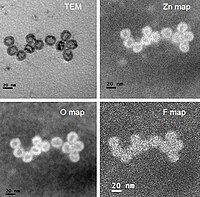
Photo from wikipedia
Herein, a novel hybrid magnetic core–shell fibrous silica nanocomposite (RhB–Fe3O4/MnO2/SiO2/KCC-1) probe-based chemosensor was designed and its behaviour towards Cu(II) metal ion was investigated using a fluorescence spectrometer. The organic receptor… Click to show full abstract
Herein, a novel hybrid magnetic core–shell fibrous silica nanocomposite (RhB–Fe3O4/MnO2/SiO2/KCC-1) probe-based chemosensor was designed and its behaviour towards Cu(II) metal ion was investigated using a fluorescence spectrometer. The organic receptor rhodamine B (RhB) fluorophore derivative was covalently grafted onto the surface of the magnetic core–shell fibrous silica nanocomposite. This sensing probe achieved the selectivity towards Cu(II) in an aqueous solution, and other competing metal ions basically induced no spectral change. Thus, this sensing probe can work as a Cu(II) selective fluorescent sensor. The synthesized material was characterized using transmission electron microscopy (TEM), scanning electron microscopy-energy dispersive spectroscopy (SEM-EDS), surface analysis (with BET), Fourier transform infrared spectroscopy (FT-IR), X-ray diffractometry, and thermogravimetric analysis (TGA). The rhodamine B derivative has a unique signalling probe that exhibits a turn-on fluorescence enhancement upon the recognition of Cu(II) ion with an excitation at 569 nm. The linearity of the Stern–Volmer plot (R2 = 0.9882) and the detection limit of 12.3 × 10−8 M were achieved. Finally, the sensor was tested to detect Cu(II) ion in different real water samples.
Journal Title: RSC Advances
Year Published: 2017
Link to full text (if available)
Share on Social Media: Sign Up to like & get
recommendations!